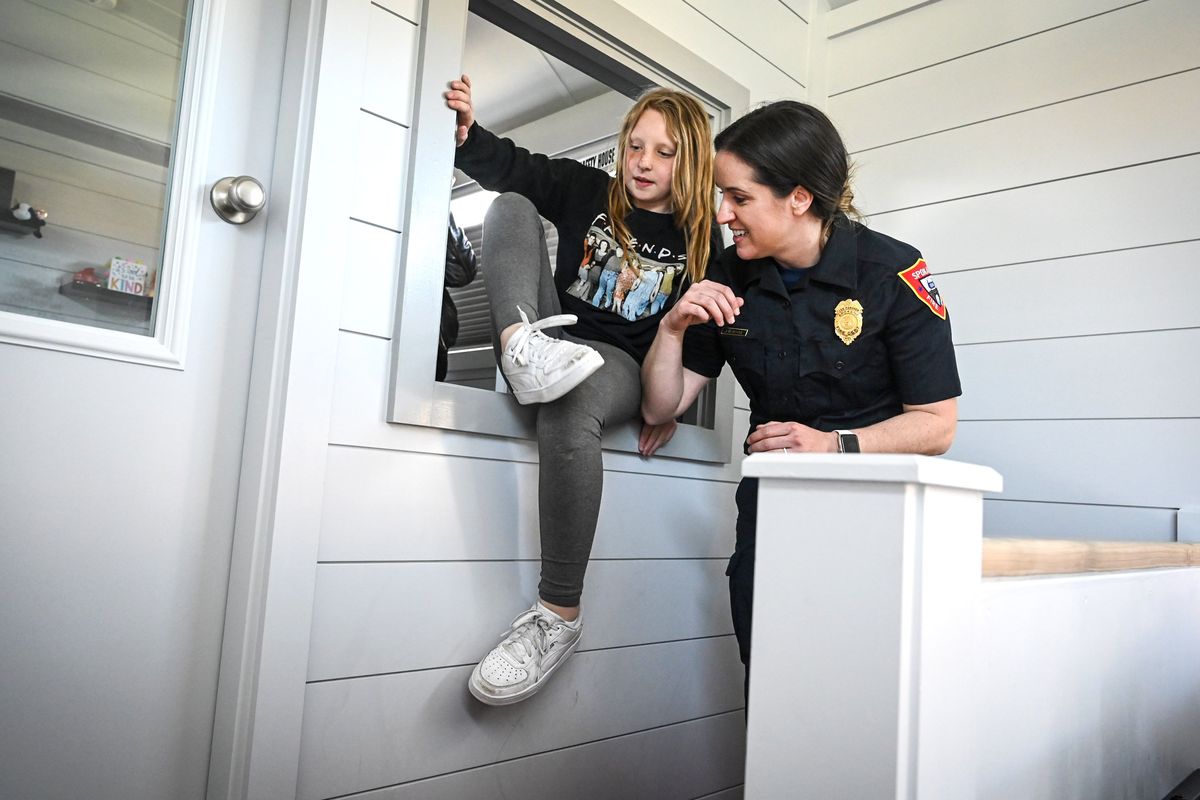‘If we saved one life, that’s a plus’: Finch Elementary students learn fire safety lessons inside new Spokane Fire Department trailer

Finch Elementary School students called 911 for a fire, climbed out a window and stopped, dropped and rolled Wednesday afternoon.
There was no actual emergency.
The students were simply learning from Spokane Fire Department officials who were conducting fire safety tips and demonstrations inside a new Children’s Fire Safety House trailer.
“I thought it was amazing, and it taught me a lot,” said Josie Day, a third-grader at Finch.
Josie said she enjoyed jumping out a bedroom window, which fire officials explained could be necessary if a fire traps someone in a room.
The department educated Spokane children using the department’s old Safety House since 1992. Its previous trailer lasted three decades before the department retired it, said Lance Dahl, deputy chief of fire prevention. The truck that towed the trailer was about 50 years old.
“It’s been a long time coming,” Dahl said.
The new gray trailer, with black trim, red doors and a “911” address on the side, was in its second day of operation Wednesday outside Finch. A new white truck was parked in front of the trailer ready to pull it.
The truck and trailer cost nearly $200,000, mostly covered by federal American Rescue Plan Act funds the city received. The Rotary Club of Spokane 21 and Spokane Aurora Northwest Rotary Club pitched in $25,000.
Michael Pallardy, former president of Spokane Aurora Northwest, said children remember these life-long lessons.
“It’s training that they’ll have for the rest of their lives,” Pallardy said.
Bill Reed, president of Spokane Aurora Northwest, said Spokane Rotary Clubs financed the original Safety House in the 1990s. The recent $25,000 helped fund the new truck.
“If we saved one life, that’s a plus,” Reed said.
The trailer is divided into two classrooms, equipped with padded benches for students.
Jerry Sander, fire equipment operator, and Jamie Wiggins, community risk reduction specialist, explained from one of the classrooms kitchen fire safety, the stop, drop and roll technique, and how to make a 911 call.
A photo of four boys who lost their lives nearly 30 years ago in a north Spokane house fire was displayed in the classroom to honor them.
Rob and Jill Schliebe’s children – Derek, 8; Loren, 6; Steven, 4, and Justin, 2 – died of smoke inhalation and burns in the two-story home in 1995. Rob and Jill Schliebe were seriously injured trying to rescue their children and jumping out a second-story window.
Sander said his wife taught Derek, who was a third-grader at Holmes Elementary School.
“I remember the day my wife came home and said, ‘I had a student die in a house fire last night,’ ” Sander said. “She was devastated. She cried all night long.”
Sander described the mistakes the Schliebe family made that day, like not blowing out a burning candle, which started the fire, and how the students can learn from them.
“We don’t want this to happen anymore,” Sander said.
Dahl said the deadly fire was one of the first major fires he responded to in his first year with the department.
“That fire really drove me to get involved in the Children’s Fire Safety House,” said Dahl, who drove the trailer around for about a decade after the 1995 fire.
One of the students Wednesday volunteered to make a 911 call, which was directed to Wiggins, who acted as a 911 operator outside the trailer.
“There is a fire in my house right now,” the student said.
Sander outlined the importance of knowing the address of the students’ homes, so first responders know exactly where to go in case of a fire or other emergency.
Another student laid on his stomach and rolled over several times to demonstrate the “stop, drop and roll” technique in case clothing caught fire.
In the other classroom, Lt. Justin Wells and Jamie McIntyre, community risk reduction manager, taught students about smoke alarms and how to escape out a bedroom window.
McIntyre played the sound of a beeping smoke alarm, and Wells told the students they needed to get out of the house if they heard it.
“Run, run, run,” he said.
They also played the noise the alarm makes when a smoke alarm needs its batteries changed.
McIntyre taught students the “monkey bar technique” to escape from a window. One-by-one, students threw one leg at a time over the windowsill in the trailer before lowering themselves down.
Wells said deploying a large rope with knots or a ladder outside the window are other options to escape.
Dahl said the fire department has taught about 65,000 students through the Safety House program, or about 3,000 each year.
He said many fire departments have a Safety House travel trailer to educate children, but the Spokane Fire Department’s is specially designed for classroom learning.